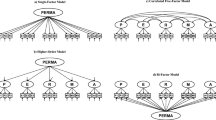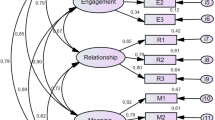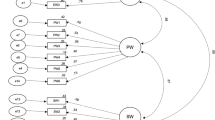Abstract
This paper reports on an investigation of the psychometric properties of the PERMA Profiler—a popular measure of well-being—with a large sample of Australian adults (n = 1942). We assessed the factor structure, scale reliability, and convergent and discriminant validity of the Profiler. Theory and evidence point to a second-order factor structure whereby the five PERMA elements constitute first-order factors that in turn load on a single general well-being factor. The Profiler displayed acceptable reliability for all subscales except Engagement and demonstrated the expected convergent relationships with measures of Flourishing, Optimism, Depression, and Psychological Distress. Further, the expected discriminate relationships were observed with measures of Anxiety and Stress. An important contribution of this research is to suggest that the elements of the Profiler all reflect, to an extent, a single general well-being factor. At a practical level, we provide information on the strengths and limitations of the Profiler in order to aid researchers and practitioners in their work.
Similar content being viewed by others
Notes
Due to the various demands of each project, a different set of scales was used with each. This limitation is covered in more detail in the Discussion. Refer to Table 6 for an indication of the scales used with each sample.
In the original instructions for the PERMA Profiler (Butler and Kern 2016), overall well-being is calculated as the mean of the 15 PERMA items and the single happiness item. However, using the single happiness item to calculate overall well-being is not consistent with PERMA theory or the factor structures tested in the present investigation. Therefore, throughout this paper we calculate overall well-being using only the 15 PERMA items.
Thanks to an anonymous reviewer for highlighting this issue.
Abbreviations
- PERMA:
-
Seligman’s (2011) PERMA-framework of well-being, consisting of Positive emotion, Engagement, Relationships, Meaning, and Accomplishment.
References
Andersen, L. S., Grimsrud, A., Myer, L., Williams, D. R., Stein, D. J., & Seedat, S. (2011). The psychometric properties of the K10 and K6 scales in screening for mood and anxiety disorders in the south African stress and health study. International Journal of Methods in Psychiatric Research, 20(4), 215–223. https://doi.org/10.1002/mpr.351.
Antony, M. M., Bieling, P. J., Cox, B. J., Enns, M. W., & Swinson, R. P. (1998). Psychometric properties of the 42-item and 21-item versions of the depression anxiety stress scales in clinical groups and a community sample. Psychological Assessment, 10(2), 176–181. 1040-3590/984/.
Ayşe, E. B. (2018). Adaptation of the PERMA well-being scale into Turkish: Validity and reliability studies. Educational Research and Reviews, 13(4), 129–135.
Bartholomaeus, J. D., Van Agteren, J. E., Iasiello, M. P., Jarden, A., & Kelly, D. (2019). Positive aging: The impact of a community wellbeing and resilience program. Clinical Gerontologist, 42(4), 377–386. https://doi.org/10.1080/07317115.2018.1561582.
Burnham, K. P., & Anderson, D. R. (2002). A practical information-theoretic approach. Model selection and multimodel inference, 2nd ed. Springer, New York.
Butler, J., & Kern, M. L. (2016). The PERMA-profiler: A brief multidimensional measure of flourishing. International Journal of Wellbeing, 6(3), 1–48.
Buuren, S., & Groothuis-Oudshoorn, K. (2010). Mice: Multivariate imputation by chained equations in R. Journal of Statistical Software, 45(3).
Clifton, J. D. W., Baker, J. D., Park, C. L., Yaden, D. B., Clifton, A. B. W., Terni, P., Miller, J. L., Zeng, G., Giorgi, S., Schwartz, H. A., & Seligman, M. E. P. (2018). Primal world beliefs. Psychological Assessment, 31(1), 82–99. https://doi.org/10.1037/pas0000639.
Crawford, J. R., & Henry, J. D. (2003). The depression anxiety stress scales (DASS): Normative data and latent structure in a large non-clinical sample. British Journal of Clinical Psychology, 42, 111–131. https://doi.org/10.1348/014466503321903544.
Csikszentmihalyi, M. (1997). Flow and the psychology of discovery and invention. New York: HarperPerennial.
Diener, E. D., Emmons, R. A., Larsen, R. J., & Griffin, S. (1985a). The satisfaction with life scale. Journal of Personality Assessment, 49(1), 71–75. https://doi.org/10.1207/s15327752jpa4901_13.
Diener, E. D., Larsen, R. J., Levine, S., & Emmons, R. A. (1985b). Intensity and frequency: Dimensions underlying positive and negative affect. Journal of Personality and Social Psychology, 48(5), 1253–1265. https://doi.org/10.1037/0022-3514.48.5.1253.
Diener, E. D., Wirtz, D., Tov, W., Kim-Prieto, C., Choi, D. W., Oishi, S., & Biswas-Diener, R. (2010). New well-being measures: Short scales to assess flourishing and positive and negative feelings. Social Indicators Research, 97(2), 143–156. https://doi.org/10.1007/s11205-009-9493-y.
Garcia, D., Moradi, S., Amato, C., Granjard, A., & Cloninger, K. (2018). Well-being and moral identity. PsyCh journal, 7(1), 53–54. https://doi.org/10.1002/pchj.205.
Glaesmer, H., Rief, W., Martin, A., Mewes, R., Brähler, E., Zenger, M., & Hinz, A. (2012). Psychometric properties and population-based norms of the life orientation test revised (LOT-R). British Journal of Health Psychology, 17, 432–445. https://doi.org/10.1111/j.2044-8287.2011.02046.x.
Goodman, F. R., Disabato, D. J., Kashdan, T. B., & Kauffman, S. B. (2017). Measuring well-being: A comparison of subjective well-being and PERMA. The Journal of Positive Psychology, 13(4), 321–332. https://doi.org/10.1080/17439760.2017.1388434.
Hinkle, D. E., Wiersma, W., & Jurs, S. G. (2003). Applied statistics for the behavioral sciences. Boston: Houghton Mifflin.
Hone, L. C., Jarden, A., & Schofield, G. (2014). Psychometric properties of the flourishing scale in a New Zealand sample. Social Indicators Research, 119(2), 1031–1042. https://doi.org/10.1007/s11205-013-0501-x.
Iasiello, M., Bartholomaeus, J., Jarden, A., & Kelly, G. (2017). Measuring PERMA+ in South Australia, the state of wellbeing: A comparison with national and international norms. Journal of Positive Psychology and Wellbeing, 1(2), 53–72.
Irwing, P., & Hughes, D. J. (2018). Test development. In P. Irwing, T. Booth, & D. J. Hughes (Ed.), The Wiley Handbook of Psychometric Testing (pp. 3–47). Wiley & Sons. https://doi.org/10.1002/9781118489772.
Kern, M. L., Waters, L., Adler, A., & White, M. (2014). Assessing employee wellbeing in schools using a multifaceted approach: Associations with physical health, life satisfaction, and professional thriving. Psychology, 5(6), 500–513. https://doi.org/10.4236/psych.2014.56060.
Kern, M. L., Zeng, G., Hou, H., & Peng, K. (2018). The Chinese version of the EPOCH measure of adolescent well-being: Testing cross-cultural measurement invariance. Journal of Psychoeducational Assessment, 0(0), 1–13. doi:https://doi.org/10.1177/0734282918789561.
Kessler, R. C., Andrews, G., Colpe, L. J., Hiripi, E., Mroczek, D. K., Normand, S.-L., et al. (2002). Short screening scales to monitor population prevalences and trends in non-specific psychological distress. Psychological Medicine, 32(6), 959–976. https://doi.org/10.1017/S0033291702006074.
Keyes, C. L. (2005). Mental illness and/or mental health? Investigating axioms of the complete state model of health. Journal of Consulting and Clinical Psychology, 73(3), 539–548. https://doi.org/10.1037/0022-006X.73.3.539.
Khaw, D., & Kern, M. (2015). A cross-cultural comparison of the PERMA model of well-being. Undergraduate Journal of Psychology at Berkeley, University of California, 8, 10–23.
Krabbe, J., & Forkmann, T. (2012). Frequency vs. intensity: Which should be used as anchors for self-report instruments? Health and Quality of Life Outcomes, 10(1), 107–115.
Lai, M. K., Leung, C., Kwok, S. Y. C., Hui, A. N. N., Lo, H. H. M., Leung, J. T. Y., & Tam, C. H. L. (2018). A multidimensional PERMA-H positive education model, general satisfaction of school life, and character strengths use in Hong Kong senior primary school students: Confirmatory factor analysis and path analysis using the APASO-II. Frontiers in Psychology, 9, 1–11. https://doi.org/10.3389/fpsyg.2018.01090.
Lamers, S. M., Westerhof, G. J., Bohlmeijer, E. T., ten Klooster, P. M., & Keyes, C. L. (2011). Evaluating the psychometric properties of the mental health continuum-short form (MHC-SF). Journal of Clinical Psychology, 67(1), 99–110. https://doi.org/10.1002/jclp.20741.
Lovett, N., & Lovett, T. (2016). Wellbeing in education: Staff matter. International Journal of Social Science and Humanity, 6(2), 107–112. https://doi.org/10.7763/IJSSH.2016.V6.628.
Marsh, H. W., Hau, K. T., & Wen, Z. (2004). In search of golden rules: Comment on hypothesis-testing approaches to setting cutoff values for fit indexes and dangers in overgeneralizing Hu and Bentler's (1999) findings. Structural Equation Modeling, 11(3), 320–341.
McNeish, D. (2018). Thanks coefficient alpha, we’ll take it from here. Psychological Methods, 23(3), 412–433. https://doi.org/10.1037/met0000144.
Organisation for Economic Co-operation and Development (OECD). (2013). OECD guidelines on measuring subjective well-being. Paris: OECD Publishing. Retrieved June, 2019, from http://www.oecd.org/statistics/Guidelines%20on%20Measuring%20Subjective%20Well-being.pdf.
Pezirkianidis, C., Stalikas, A., Lakioti, A., & Yotsidi, V. (2019). Validating a multidimensional measure of wellbeing in Greece: Translation, factor structure, and measurement invariance of the PERMA profiler. Current Psychology, 1–18. https://doi.org/10.1007/s12144-019-00236-7.
Revelle, W. (2019). psych: Procedures for Psychological, Psychometric, and Personality Research. Northwestern University, Evanston, Illinois. R package version 1.9.12, https://CRAN.R-project.org/package=psych
Rosseel, Y. (2012). Lavaan: An R package for structural equation modeling. Journal of Statistical Software, 48, 1(2), –36. https://doi.org/10.18637/jss.v048.i02.
Ryan, J., Curtis, R., Olds, T., Edney, S., Vandelanotte, C., Plotnikoff, R., & Maher, C. (2019). Psychometric properties of the PERMA profiler for measuring wellbeing in Australian adults. PLoS One, 14(12), 1–12. https://doi.org/10.1371/journal.pone.0225932.
Satorra, A., & Bentler, P. M. (1994). Corrections to test statistics and standard errors in covariance structure analysis. In A. von Eye & C. C. Clogg (Eds.), Latent variables analysis: Applications for developmental research (pp. 399–419). Thousand Oaks: Sage Publications, Inc..
Scheier, M. F., Carver, C. S., & Bridges, M. W. (1994). Distinguishing optimism from neuroticism (and trait anxiety, self-mastery, and self-esteem): A re-evaluation of the life orientation test. Journal of Personality and Social Psychology, 67(6), 1063–1078. https://doi.org/10.1037/0022-3514.67.6.1063.
Seligman, M. E. (2011). Flourish: A visionary new understanding of happiness and well-being. New York: Simon and Schuster.
Seligman, M. E. (2018). PERMA and the building blocks of well-being. The Journal of Positive Psychology, 13(4), 333–335. https://doi.org/10.1080/17439760.2018.1437466.
Sellbom, M., & Tellegen, A. (2019). Factor analysis in psychological assessment research: Common pitfalls and recommendations. Psychological Assessment, 31(12), 1428–1441. https://doi.org/10.1037/pas0000623.
Seppälä, P., Mauno, S., Feldt, T., Hakanen, J., Kinnunen, U., Tolvanen, A., & Schaufeli, W. (2009). The construct validity of the Utrecht work engagement scale: Multisample and longitudinal evidence. Journal of Happiness Studies, 10(4), 459. https://doi.org/10.1007/s10902-008-9100-y.
Steiger, J. H. (1980). Tests for comparing elements of a correlation matrix. Psychological Bulletin, 87(2), 245–251. https://doi.org/10.1037//0033-2909.87.2.245.
Sun, J., Kaufman, S. B., & Smillie, L. D. (2018). Unique associations between big five personality aspects and multiple dimensions of well-being. Journal of Personality, 86(2), 158–172. https://doi.org/10.1111/jopy.12301.
Umucu, E., Wu, J. R., Sanchez, J., Brooks, J. M., Chiu, C. Y., Tu, W. M., & Chan, F. (2019). Psychometric validation of the PERMA-profiler as a well-being measure for student veterans. Journal of American College Health, 68(3), 1–7. https://doi.org/10.1080/07448481.2018.1546182.
Wammerl, M., Jaunig, J., Mairunteregger, T., & Streit, P. (2019). The German version of the PERMA-profiler: Evidence for construct and convergent validity of the PERMA theory of well-being in German speaking countries. Journal of Well-Being Assessment, 3(2–3), 75–96. https://doi.org/10.1007/s41543-019-00021-0.
Wang, T. L., & Vella-Brodrick, D. A. (2017). Examining screen time, screen use experiences, and well-being in adults. Social Networking, 7(1), 32–44. https://doi.org/10.4236/sn.2018.71003.
Watanabe, K., Kawakami, N., Shiotani, T., Adachi, H., Matsumoto, K., Imamura, K., . . . Kern, M. L. (2018). The Japanese workplace PERMA-Profiler: A validation study among Japanese workers. Journal of Occupational Health. doi:https://doi.org/10.1539/joh.2018-0050-OA.
Zimmerman, D. W., & Williams, R. H. (1997). Properties of the spearman correction for attenuation for normal and realistic non-normal distributions. Applied Psychological Measurement, 21(3), 253–270. https://doi.org/10.1177/01466216970213005.
Acknowledgments
We would like to thank Tania Marin, a former colleague at the South Australian Health and Medical Research Institute, for survey design and data collection.
Author information
Authors and Affiliations
Corresponding author
Ethics declarations
Conflict of Interest
no conflicts of interest noted.
Additional information
Publisher’s Note
Springer Nature remains neutral with regard to jurisdictional claims in published maps and institutional affiliations.
Supplementary Information
ESM 1
(DOCX 59 kb)
Rights and permissions
About this article
Cite this article
Bartholomaeus, J.D., Iasiello, M.P., Jarden, A. et al. Evaluating the Psychometric Properties of the PERMA Profiler. J well-being assess 4, 163–180 (2020). https://doi.org/10.1007/s41543-020-00031-3
Accepted:
Published:
Issue Date:
DOI: https://doi.org/10.1007/s41543-020-00031-3




